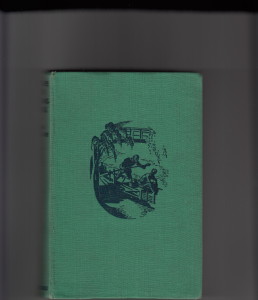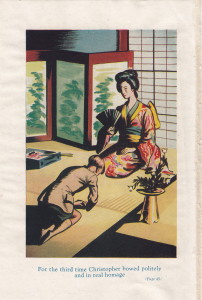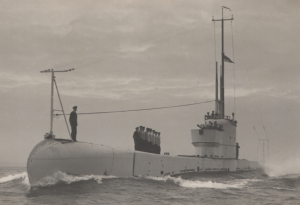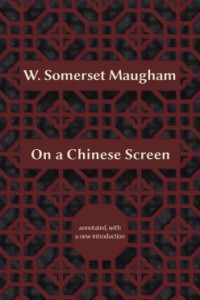Posted: February 21st, 2014 | No Comments »
Below is the cover and a colour illustration from the author Jan Maclure’s Escape to Chungking, published by the Oxford University Press in 1942. This is an interesting book as little is known about the author yet it was widely read at the time of publication and was what would now be called a Young Adult “YA” book – this copy was given to my aunt (then a teenager) shortly after the war. The book deals with the fall (then very recent) of Singapore and Malaya to the Japanese – the book is dedicated to “Friends who have not yet got out”. A 14 year old boy carries secrets across war torn Asia from Japan to Chungking (China’s war time capital) and the detail is rather good. The book has a variety of black and white illustrations (by Jack Matthews) and one colour print at the start (shown below).
Maclure herself remains a mystery with no other published books credited to that name and “Jan” may be a pseudonym so we can’t even be sure of the author’s gender. OUP, rather sloppily, have apparently destroyed their records from that period!
And that’s all I know….(though Owen Dudley Edwards’s British Children’s Fiction in the Second World War has more details)


Posted: February 20th, 2014 | No Comments »
A piece by me on Jack London’s coverage of the Russo-Japanese War a hundred and ten years ago….click here

Jack London (left, with cap and fag) with the Japanese in Korea, 1904
Posted: February 19th, 2014 | 1 Comment »
After yesterdays postcard of an American hotel’s version of Macao in the 1960s, here’s the real thing – before it went boom!!

Posted: February 18th, 2014 | No Comments »
Stay at the Sheraton in Dallas, Texas in the 1960s and an evening meal in the Macao Room was yours for a reservation. The rather uninteresting hotel was built in 1959 (though was a rather modern structure then)

who wouldn’t want dinner in the Macao room?
Where this was in the building I don’t know. According to the hotel’s website they have one restaurant now called The Kitchen Table. I’ll leave it up to you choose which you feel had more style and sophistication….
 Who would want dinner in The Kitchen Table!!
Who would want dinner in The Kitchen Table!!
Posted: February 18th, 2014 | No Comments »
RAS Ad Hoc Study Group
WEDNESDAY 19th February 2014
7pmÂ
Â
The Apartment
(47 Yongfu Lu, near Wuyuan Lu)
The Poseidon Project

RAS hosts the Shanghai premier of this new documentary, presented by the director Arthur Jones.
Â
Â
Â
An American scuba diver.
A lost British submarine.
A secret Chinese history.
The Poseidon Project is a documentary about a British submarine that sank off the coast of China in 1931, and the American explorer who spent six years looking for it.
In 1931, Britain’s most advanced submarine sank off the coast of China. Three hours later, six sailors became the first men to escape from a sunken sub using a proto-scuba device. But what became of the lost submarine? Steven Schwankert’s six-year obsession with HMS Poseidon uncovered a secret history.
Beijing-based journalist and part-time scuba instructor Steven Schwankert was looking for interesting wrecks to dive in northern China when he found HMS Poseidon on a list of unexplored dive sites. His private obsession with bringing wreck diving to China became a public and personally high-risk mission to uncover a secret history of political intrigue that took him half way across the world in search of evidence.
On June the 9th 1931, one of Britain’s most advanced submarines collided with a cargo ship off the coast of China. Half of the crew escaped in the first few seconds, but the rest of the men sank 40 metres down to the bottom of the sea, entombed in their boat. Three hours later, six sailors surfaced, barely conscious and bitterly cold, as their comrades watched on in amazement. They were the first men ever to escape alive from a sunken submarine using a proto- scuba device.
Their story hit newspaper headlines worldwide and went on to inspire a feature film, released later that year. Their miraculous escape changed marine safety forever, leading to a revolution in submarine design and a big leap forward in our understanding of decompression sickness. But their names, and their submarine, gradually sank into obscurity.
Steven Schwankert’s six-year search for the submarine revealed a story that was far more complicated than he had first expected, challenging official accounts of the escape, and uncovering the truth behind the forgotten wreck.
Arthur and Luther Jones’ previous work includes A Farewell Song, a documentary about a group of retired Chinese musicians who reunite to perform a series of concerts outside of the state-backed music system. The film won the Special Jury Prize for Documentaries at the 2006 Syracuse International Film Festival. The British brothers have also made commissioned films for the Special Olympics movement and the World Expo.
“The challenge in making The Poseidon Project was to take subject matter that might seem like the basis for a traditional maritime history documentary and make it feel urgent and personal. The submarine’s story was clearly very interesting and as we learnt more about its fate, and about the crew and their experiences on board, we knew we had a fascinating moment of history on our hands.
But the truth is that we were drawn to the story initially because of Steven Schwankert as much as the submarine. We liked the way he didn’t hide his emotional journey. On days when he was feeling like the project was coming apart at the seams, he didn’t stop himself from appearing grumpy on camera. And when his discoveries excited him, he beamed like a child. He also had a deep understanding of what it means to live and work in China – the importance of knowing when to push hard and when to tread softly. That made his story all the more intriguing.â€
ENTRANCE: Â Members 70 RMB – Non Members 100 RMB
WEBSITE: Â www.royalasiaticsociety.org.cn
Posted: February 17th, 2014 | 1 Comment »
The People’s Friend (my grandmother’s favouite read), known as “the famous story magazine” began publoishing in 1869. This issue is from 1960 and is a rather turgid story set in Scotland. However, a wee touch of Chinoiserie crept in, courtesy of the cover designer (uncredited) – note the statue and picture on the wall. Neither are mentioned in the story so must have been the designer’s own idea.

Posted: February 16th, 2014 | No Comments »
Mentioning Taiwan and the preservation battle currently underway in Keelng at the moment yesterday I thought another Taiwan post called for. Anyone who reads widely (or even not that widely) on China knows that Taiwan is greatly under-served in terms of books, studies, histories and memoirs in English. I’ve always been shocked at how many “China Hands” have rarely, if ever, set foot on the island or anywhere in the Republic. The tsunami wave of books on mainland China (of which I openly admit to having contributed far more than my share) has left Taiwan marginalised, and this is not a good thing. For me Taipei is a wonderful and engaging city with a fascinating history and a place I long to return to as soon as I leave. I know the rest of the island far less well, but have never found anywhere I didn’t like. The PRC uber-boosters may scoff but Taiwan is a model for the mainland and the sooner the mainland looks and feels like Taiwan the better I say.
Hence a plug for the newly launched Camphor Press, of which I know little except that they are rolling out a great series of books on Taiwan (and mainland China). Among their initial offering are, what looks to be, a fascinating book The Flight of the Lapwing: A Naval Officers Jottings in China, Formosa and Japan by Henry Shore, a Royal Navy officer attached to the old “China Station” and a welcome reprint of Somerset Maugham’s irreverent and ever re-readable On a Chinese Screen describing the great man’s roamings through China in 1919.
there’s more – check out their website and the best of luck to them…


Posted: February 15th, 2014 | No Comments »
Keelung in Taiwan is my kind of town – a gritty port city that has just the right amounts of seediness, dirt and charm. It also has a fascinating history both in terms of the foreign presence in Taiwan (about which I’ve blogged repeatedly – see below pic for details and links) but also as one of the major arrival points for the Nationalist Army in 1949. This latter fact is the reason behind the current preservation battle over a cluster of otherwise unassuming warehouses on the waterfront. The threatened structures are the only two remaining buildings of a group of eight warehouses built in 1932 – since then they’ve seen the arrival of many Japanese during the occupation period and then the Nationalists. Between 1945 and 1949, at the port’s peak, more than 50 ferry boats docked at Keelung every day from Guangzhou, Xiamen, Wenzhou, Shanghai and other Chinese cities, most ferrying KMT troops and ordinary folk fleeing the Communists. Let’s hope the alliance of preservation activists and academics in Keelung can save these buildings. History isn’t always about grand and grandiose structures.

Some more great Keelung architecture here (taken in 2010)
A post of Keelung’s Ershawan Fort here
Keelung’s monument to Prince Kitashirakawa here
A post on Keelung’s French Cemetery here
the marvellous Keelung Harbour Integrated Administration Building here










